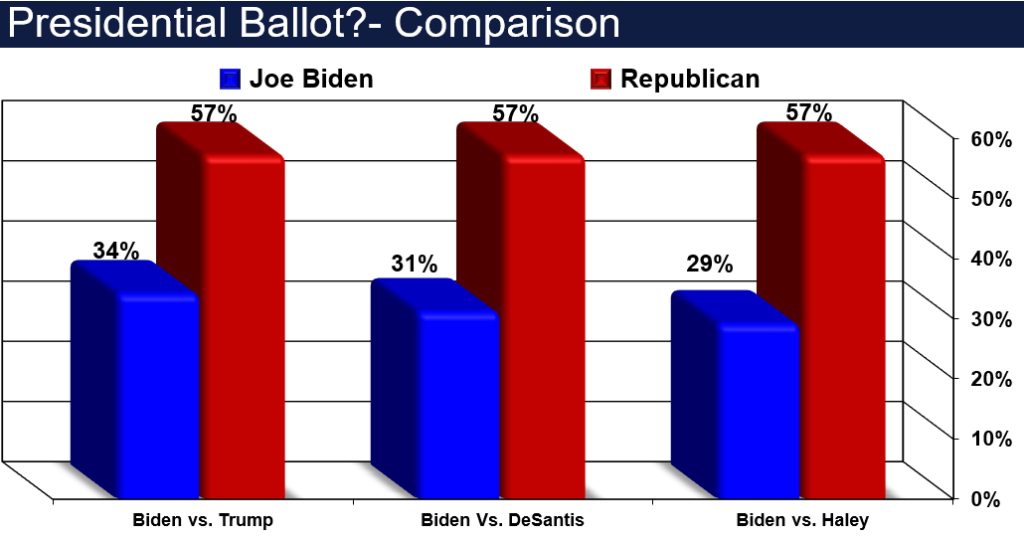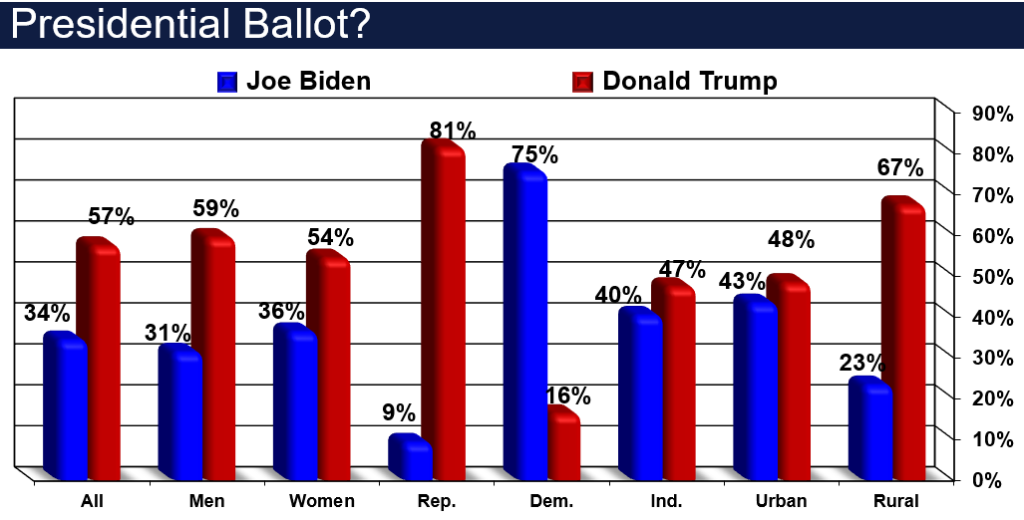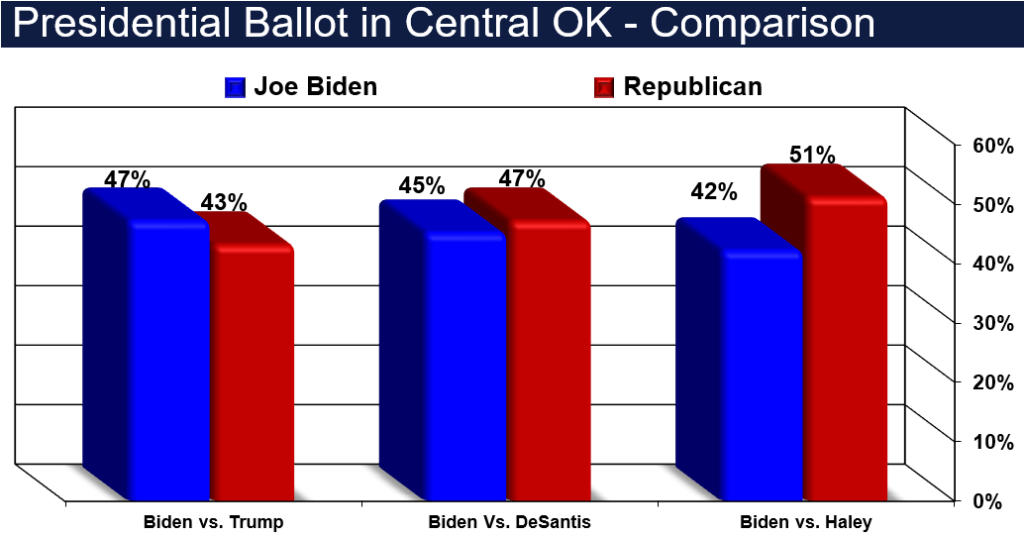In Central OK, Presidential nominee might make a difference
Sooner Survey: Volume 35 No. 3 | July 13, 2023
By Pat McFerron, President
Cole Hargrave Snodgrass & Associate
![]() @McFerron
@McFerron
During the summer of the non-election year, attentions have been turning to national politics and the pending presidential contest of next year. In April, we released numbers (https://chs-inc.com/sooner-survey-trump-complicated/) showing Donald Trump’s popularity among Republicans, but with Ron DeSantis within striking distance.
The reality is, it is a forgone conclusion that whoever the Republicans nominate to take on President Joe Biden, Oklahoma will vote Republican. But the more interesting question is does who Republicans nominate matter to other contests in this very Republican state.
Oklahoma is a Republican state, and we see no signs of that changing. During our 30 years of polling the generic legislative ballot, only at a few points have we seen the Republican advantage exceed the 25 points it is today (55% Republican / 30% Democrat). While we have seen the generic narrow a bit as we move toward elections, 2024 is shaping up to be a very strong year for Oklahoma Republicans, albeit in an election cycle with few statewide offices on the ballot.
At this time, we see Republicans as united as we ever have – only 5% of Registered Republicans say they will vote for a generic Democrat while 84% commit to the unnamed Republican. Democrats in the state are also united, just not to that extreme (11% voting Republican; 72% committing to vote Democratic). In the two great metro areas, the generic contest is much closer (47% Republican; 40% Democrat) than in the 71 rural counties (65% Republican; 19% Democrat). The possibility of Democrats making any gains in rural Oklahoma seems extremely far-fetched at this time.
When moving up the ballot to the presidential contests, we again see Republican domination. For the purposes of this research, we tested three different Republicans against Joe Biden: Donald Trump, Ron DeSantis, and Nikki Haley. All three of these candidates hit 57% of the vote in a general election, but Biden’s percentage does vary a little. Biden’s best showing is against Trump (34%) and his worst against Haley (29%) with DeSantis in the middle (31%). From a statewide perspective, these differences are generally minimal. For example, Trump has a 72-point advantage among Republicans, DeSantis is at 73% and Haley is at 69%. Trump leads Biden in rural areas by 44%, the same as DeSantis, and just one point more than Haley (19% Biden / 62% Haley). Trump wins Independents by seven (40% Biden; 47% Trump), DeSantis has a 12 point lead among this relatively small group (36% Biden; 48% DeSantis) and Haley builds a lead to 19 points (33% Biden; 52% Haley).
When delving deeper into the crosstabulations, however, there are a few that jump out. While one might expect Haley’s difference to be along gender lines, the data does not back that up. Statewide, Trump wins Oklahoma women by 18 (36% Biden vs. 54% Trump) while DeSantis wins by 21 (33% Biden vs. 54% DeSantis) and Haley by 20 (32% Biden vs. 52% Haley). The key difference in the various ballots, however, is geographical. Almost all of the differences in statewide performance occurs in central Oklahoma.
When looking at the central Oklahoma crosstab – made up of the voters in Oklahoma, Cleveland and Canadian counties (comprising 32% of all Oklahoma voters) — we see significant differences in presidential performance. Of the three tested Republicans, Donald Trump is the only one that loses to Biden in these counties combined, trailing Biden by four points (47% Biden vs. 43% Trump). DeSantis carries the area by two (45% Biden vs. 47% DeSantis) while Haley expands that lead to nine points (42% Biden vs. 51% Haley).
For countywide candidates – particularly in Oklahoma County – who Republicans nominate could play a critical role as it can set the stage for those contests. Clearly, a Republican down-ballot contest would prefer to see the top of the ticket win by nine than lose by four.
It should be noted, however, that Oklahoma County’s recent history has shown that county offices have performed more Republican than the top of the ticket – especially for incumbents. For example, in 2020, Trump won Oklahoma County with 49% of the vote besting Biden by just over 1%. In this environment, the open Sheriff’s race was won by Republican Tommie Johnson by roughly five points, besting the top of the ticket and countywide incumbents like Rick Warren who won by almost 14 points. In 2022, despite Kevin Stitt losing the county by 13-points, Assessor Larry Stein won reelection by 10 points as did Treasurer Butch Freeman, although the open District Attorney seat went to Democrat Vicki Behenna.
We are still a long way from the 2024 general elections, but Oklahoma County will certainly be among the most interesting in Oklahoma. There is little doubt that nominating someone other than Donald Trump would help Republicans in that county. ◊












Recent Comments